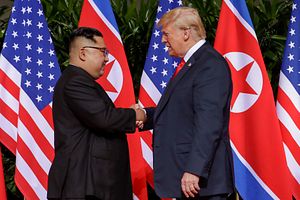On Tuesday, U.S. President Donald J. Trump and North Korean leader Kim Jong Un met in what was the first-ever U.S.-North Korea summit on Singapore’s Sentosa Island. Their meeting began with a handshake in front U.S. and North Korean flags and ended with the announcement of a joint declaration.
“We had a historic meeting and decided to leave the past behind,” Kim said at the signing of the joint statement with Trump. The signing came after a short one-on-one meeting between the two leaders, an expanded bilateral session with aides present, and a working lunch.
The declaration itself sets out both sides to a familiar agenda. While it does make reference to the word “denuclearization,” it does so vaguely and using the April 27, 2018, formulation agreed to by South Korean President Moon Jae-in and Kim Jong Un at their summit. Per the U.S.-North Korea summit declaration, North Korea would agree to “work toward complete denuclearization of the Korean Peninsula.”
The core exchange at the heart of the agreement was a commitment by Trump to give North Korea “security guarantees”—unspecified in the text of the agreement—in exchange for Kim committing to “complete denuclearization of the Korean Peninsula.” The formulation of “complete denuclearization” notably falls short of the long-sought U.S. objective in North Korea of the “complete, verifiable, and irreversible dismantlement” of North Korea’s nuclear weapons and weapons of mass destruction.
The Trump-Kim declaration also hails the “establishment of new U.S.-DPRK relations and the building of a lasting and robust peace regime on the Korean Peninsula.” Toward the latter point, Trump, in the aftermath of the signing, announced that he would be willing to stop U.S. military exercises with South Korea, which North Korea sees as a regular, large-scale ruse to stage an invasion of the North. Trump described the exercises as “provocative.”
Not included in the declaration specifically, but apparently one of the lone, specific North Korean technical concession, Trump asked Kim to dismantle a ballistic missile engine test stand. “I said, ‘Do me a favor; we’ve got this missile-engine testing site. We know where it is because of the heat.’ It’s incredible the equipment we have, to be honest with you.” Kim agreed to the ask, which came after the declaration was signed by the two leaders, according to Trump.
The summit declaration marks the start of a U.S.-North Korea diplomatic process and U.S. Secretary of State Mike Pompeo is expected to follow up with a senior North Korean official to oversee the agreement’s implementation.
“The United States and the DPRK commit to hold follow-on negotiations, led by the U.S. Secretary of State, Mike Pompeo, and a relevant high-level DPRK official, at the earliest possible date, to implement the outcomes of the U.S.-DPRK summit,” the agreement notes.

































